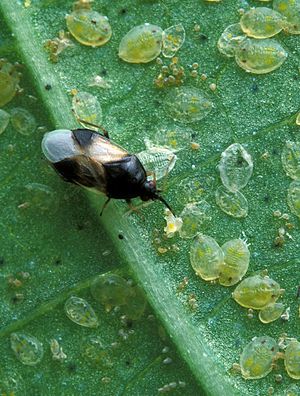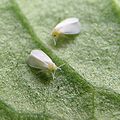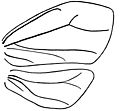Whitefly facts for kids
Quick facts for kids Whitefly |
|
|---|---|
 |
|
| Whiteflies (Trialeurodes vaporariorum) | |
| Scientific classification |
|
| Kingdom: | Animalia |
| Phylum: | Arthropoda |
| Class: | Insecta |
| Order: | Hemiptera |
| Suborder: | Sternorrhyncha |
| Superfamily: | Aleyrodoidea |
| Family: | Aleyrodidae |
| Subfamilies | |
|
Aleurodicinae |
|
| Synonyms | |
|
Aleurodidae |
|
Whiteflies are tiny insects that usually feed on the underside of plant leaves. They belong to the family Aleyrodidae. There are more than 1550 different kinds of whiteflies known around the world.
Contents
What are Whiteflies?
Whiteflies are small insects, often less than 3 mm (about 0.1 inches) wide. Most are only 1 mm to 2 mm long. They are so tiny that they can easily get into greenhouses through very fine screens. This makes them hard to control in places where plants are grown.
Some "giant whitefly" species can be bigger, over 5 mm (0.2 inches). Sometimes, males and females are different sizes. In some tropical species, the males are much larger than the females.
How Whiteflies Look
Adult whiteflies have two pairs of wings. Their wings are often covered with a fine, waxy powder. This makes them look dusty or floury, which is how they got their name. The word "Aleyrodidae" comes from a Greek word meaning "floury."
Most whiteflies are white, but some are different colors. For example, the Aleurocanthus woglumi is a dark, slaty black.
Whiteflies have well-developed antennae, which are like feelers. Most species have seven parts to their antennae. They also have two main eyes, which are quite special. These eyes often have a clear split between their top and bottom halves. This split can even separate the eye into two parts in some species.
Their legs are long and thin, but they are not made for jumping. They have two small claws on each foot.
How Whiteflies Eat
Whiteflies have special mouthparts called stylets. They use these to pierce plants and suck out their sap. This sap is called phloem.
Like many sap-sucking insects, whiteflies produce a sticky, sugary liquid called honeydew. This honeydew comes out of a special opening on their back called a vasiform orifice. This opening is unique to whiteflies and helps scientists tell different species apart. Ants often like to eat this honeydew.
Life Cycle of a Whitefly
Whiteflies lay their eggs close together on a plant, usually on a leaf. They often lay them in spiral or curved patterns. The eggs are long and have a thin stalk at one end.
Whiteflies go through four stages as larvae. The first stage has short legs and can move around. But once it starts feeding by sticking its mouthparts into the plant, it settles down. It stops using its legs, and they shrink.
From then on, the larva stays attached to the plant. The last larval stage feeds for a while, then stops. It forms a protective outer skin called a puparium. Inside this skin, the whitefly changes into an adult. When the adult is ready, it breaks out of the puparium. This stage is similar to the pupa stage in butterflies or beetles.
Why are Whiteflies Pests?
Whiteflies can cause big problems for plants, especially in warm places or in greenhouses. They cause hundreds of millions of dollars in damage to crops every year around the world.
Some common whitefly pests include:
- Aleurocanthus woglumi, also known as the citrus blackfly, which attacks citrus trees.
- Aleyrodes proletella, the cabbage whitefly, which harms cabbage and similar plants.
- Bemisia tabaci, the silverleaf whitefly, which attacks many farm crops and garden plants.
- Trialeurodes vaporariorum, the greenhouse whitefly, a major pest in greenhouses.
How Whiteflies Harm Plants
Whiteflies harm plants in a few ways:
- Sucking Sap: When many whiteflies suck sap from a plant, it weakens the plant. They also inject their saliva, which can hurt the plant even more.
- Honeydew and Sooty Mold: They produce a lot of sticky honeydew. This honeydew covers the plant and allows a black fungus called sooty mold to grow. Sooty mold makes the plant look bad and can block sunlight, making it harder for the plant to grow.
- Spreading Diseases: This is the biggest problem. Whiteflies can carry and spread plant diseases, especially viruses. The Bemisia tabaci whitefly is known to spread almost 60 different plant viruses. These viruses can cause serious damage to crops like tomatoes, beans, and sweet potatoes.
Scientists are working to find ways to control whiteflies without using too many chemicals. They are also trying to grow new types of plants that can resist whiteflies and the diseases they carry.
How to Control Whiteflies
Controlling whiteflies can be tricky because they can quickly become resistant to pesticides. Experts suggest using a plan that focuses on preventing them and using natural methods when possible.
Chemical Control
If there are many whiteflies, you might need to use a pesticide at first. However, using pesticides too often can make whiteflies resistant. It's best to use pesticides that don't harm the natural enemies of whiteflies. Some pesticides contain ingredients like clothianidin, dinotefuran, imidacloprid, and thiamethoxam. It's important to use different types of pesticides so whiteflies don't get used to one kind. Spraying leaves with insecticidal soap is another safe option.
Natural Control Methods
There are many ways to control whiteflies without using chemicals:
- Washing Plants: You can wash the plants, especially the undersides of the leaves, to reduce the number of whiteflies.
- Sticky Traps: Whiteflies are attracted to yellow. Yellow sticky paper traps can be used to catch them and see how many there are.
- Removing Infested Leaves: If some leaves are badly infested, you can remove them and dispose of them carefully to stop the whiteflies from spreading.
- Beneficial Insects: Many insects are natural enemies of whiteflies and can help control them. These include:
* Green lacewings: Their larvae eat whiteflies, aphids, and other pests. You can buy their eggs from special stores. * Ladybirds: They eat insect eggs, including whitefly eggs, and other small pests. * Minute pirate bugs, big-eyed bugs, and damsel bugs: These are also predators that eat whiteflies. * Encarsia formosa: This is a tiny wasp that lays its eggs inside whitefly larvae, killing them.
- Biopesticides: These are natural pesticides made from tiny living things like fungi. Beauveria bassiana and Isaria fumosorosea are two types of fungi that can kill whitefly larvae and adults.
Companion Plants
Some plants can be grown near vegetables in a garden to help protect them from whiteflies. This is called companion planting.
- Nasturtiums are thought to help protect gooseberries or tomatoes. They release chemicals from their roots that keep whiteflies away.
- Marigolds can repel whiteflies from tomatoes.
- Zinnias attract helpful insects like hummingbirds and predatory wasps that eat whiteflies. Other plants like the hummingbird bush, pineapple sage, and bee balm also attract these predators. Many mint plants can also hide the scent of nearby plants, making it harder for pests to find them.
Images for kids
See also
 In Spanish: Mosca blanca para niños
In Spanish: Mosca blanca para niños








